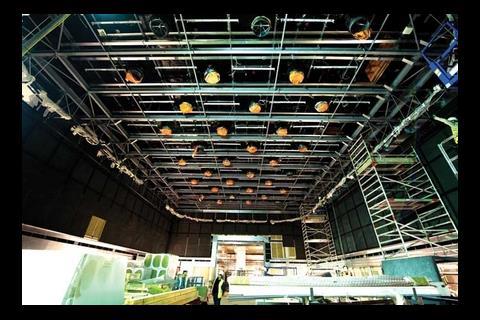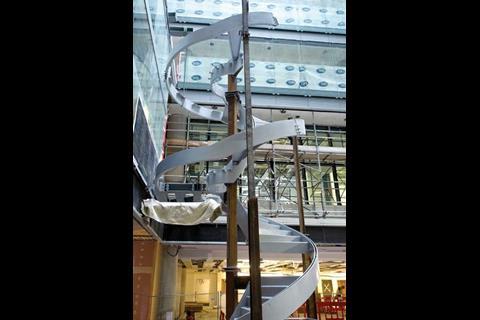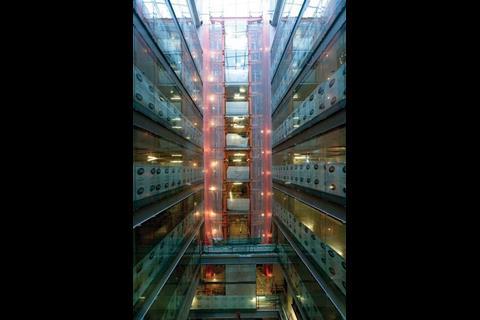With a very public dressing down still ringing in its ears, BritainŌĆÖs most venerable broadcaster has a point to prove on phase two of the ┬Ż1bn redevelopment of Broadcasting House
On a glorious March morning, the familiar sounds of a development under construction buzz and whirr from the site of the BBCŌĆÖs Broadcasting House extension. Construction workers on lunch breaks meander nearby, chatting and whistling, buoyed by the unexpected balmy weather. The scene couldnŌĆÖt be cheerier. It is almost as if the past few weeks had never happened.
Unfortunately for the BBC, they did. A report from the National Audit Office (NAO) last month accused the corporation of failing to get value for money on three major projects: its new base at MediaCity in Salford, its Scottish headquarters at Pacific Quays in Glasgow and its ┬Ż1bn redevelopment of Broadcasting House. It was the last of these that proved the most headline-grabbing. The redevelopment, the report said, was more than four years behind schedule and ┬Ż55m over budget, the first phase having ŌĆ£got into serious difficulties before the BBC took actionŌĆØ. Ever mindful of the intense scrutiny of the the corporationŌĆÖs financial management, led by the Murdoch press, the BBC Trust moved swiftly to demand a tighter strategy for the estateŌĆÖs development in future.
This means that all eyes are now on the second phase of the Broadcasting House scheme to find out if the project team can deliver the state-of-the-art production centre that has been promised by the revised deadline of April 2013. For Chris Kane, the BBCŌĆÖs head of property, the added scrutiny is of no great concern. He believes that an awful lot has already been done to improve the project over the past five years ŌĆō something he feels was not covered fully enough in the report.
║┌Č┤╔ńŪ° went behind the scenes on site to find out if this really is the case.
State of play
Kane is confident about the measures taken to claw back cost overruns. ŌĆ£We have already made back ┬Ż45m in cash by rationalising the BBC estate,ŌĆØ he says. ŌĆ£On this project specifically weŌĆÖre hoping to have all the heavy construction done on schedule before the end of 2010 and then complete the heavy technical installation and migration process by the end of 2012. WeŌĆÖre on track, if not ahead of schedule, and on budget, if not under budget.ŌĆØ
It all sounds a far cry from the shambolic first phase. The NAO report highlighted how, in that stage of the project, which involved the refurbishment of the original thirties building, there were more than 42 contract variations totalling ┬Ż13.9m, a subsequent dispute with the developer cost a further ┬Ż45m, another ┬Ż8m spent to cover overruns, ┬Ż27m for contract variations and delays and ┬Ż10m for additional costs.
The bad news is that the second phase is, in many ways, more complicated ŌĆō in the words of Nick Pollard, the chief executive of Bovis Lend Lease, which is building the scheme, they are ŌĆ£as difficult as they comeŌĆØ. The nine-storey structure, together with three basement levels, will create 16,000m2 of extra space, which is currently waiting to be equipped with 10,000 miles of cabling to supply 27 new acoustic studios, four television studios and one of the biggest live newsrooms in the world. If Kane seems unconcerned by the NAO report, it is at least partly because, as he says, ŌĆ£I have a bigger job to do hereŌĆØ.
The sheer scale of the development is the first thing that hits you as you enter the site. By 2012, the entire Broadcasting House development will cover 80,000m2, making it one of the largest live digital broadcast centres in the world. Today alone there are 1,000 workers on site over eight floors ŌĆō the ninth will be plant space. The floors have been built around a 43m high, 8.4m wide atrium topped with a glass roof. A striking helical staircase will connect the basementŌĆÖs second level to level two. Because of the double-height space, this will effectively be the first floor.
The heart of the operation, both in terms of construction and the corporationŌĆÖs service, is down in the basement, where the TV studios and newsroom will be. Even without any fittings or real orientation points, the newsroom lives up to the hype. It is a huge area, 4,000m2, with a public viewing gallery stretching most of the way around the top. ŌĆ£This newsroom will fit 500 journalists,ŌĆØ says Kane, ŌĆ£or 90 double-decker buses.ŌĆØ
Pointing to the viewing gallery he adds: ŌĆ£The public will be able to come and look in and see the BBC doing its work by directly looking down into this room. I think about 300 people will be able to fit in.ŌĆØ
This aspect of the development is central to improving the public perception of the broadcaster. ŌĆ£The BBC needs to be more open, less fortress-like. And we want people to be able to walk in and out freely rather than have a perception of high fences and barbed wire.ŌĆØ
Of course, that public perception will be sorely tested if this scheme fails to come in on time and with every extra penny justified. Kane aims to have the building fully operational at least four months ahead of April 2013 and is confident that, through changes implemented over the past five years, this is well within reach.
Some of the improvements he refers to have already been recognised by the NAO. Despite the fact that one of its criticisms of the Broadcasting House scheme was that it was badly project managed and that ŌĆ£weak governance and poor change control processes contributed to severe delays and increased costsŌĆØ, it conceded that the BBC had upped its game since phase one through more defined project roles, improved project reviews and better risk management.
Kane says strategies were being put in place as early as 2004. This is around the time he was brought on board and promptly streamlined the project management system by slashing the construction and property team from 94 to 40. Then he restructured the team to make sure they were talking regularly, sharing ideas and solving problems as one entity: ŌĆ£There are three silos in my supply chain,ŌĆØ he says. ŌĆ£They are pure property, facilities management and design and construction. Now, if those three silos donŌĆÖt talk to each other that will cost me a fortune. There are three different mindsets and three different cultures. So what weŌĆÖre trying to do at the BBC is to integrate them by eliminating references to different roles. To do this I dropped the name BBC Property five years ago [the division is now known as BBC Workplace] and I wonŌĆÖt have any property industry titles anymore.
ŌĆ£In my world now we do two things: we operate the estate and we change the estate. There is no mention of property management, no longer a design team and no longer a construction management group. Everything is just part of the supply chain.ŌĆØ
Kane adds that there is also now a dedicated programme management office, set up in 2009, to make sure that every part of the delivery of New Broadcasting House is planned within an inch of its life, budgeted for and, most importantly, staffed appropriately with people who understand the complexities of building a broadcasting base.
This last point is one of the clearest changes implemented on phase two. The NAO report criticised the BBC for ŌĆ£not systematically identifying the skills it requires to deliver projects.ŌĆØ However, Paul Sims, operations director for Bovis on the scheme, points to the workers on site during ║┌Č┤╔ńŪ°ŌĆÖs visit as evidence of a shift in approach. ŌĆ£There has to be a realisation that this is not an office building,ŌĆØ he says, stopping the site visit for a second. ŌĆ£Compared with the first phase, where there were not enough technically skilled staff on site, out of the 837 workers and 130 managers on site today, 50% are technical and acoustics specialists, or people who have already had experience working on this kind of project.ŌĆØ
The BBC has also taken on several more unusual recruits. For example, the person leading the project to bring both buildings into a single entity with shared utilities is an air-traffic controller. ŌĆ£We needed someone with a track record of working in a highly pressured environment,ŌĆØ says Kane. ŌĆ£Someone who knows how to deal with a huge number of variants while keeping an overarching system up and running.ŌĆØ

Keeping things simple
The financial planning for Broadcasting House was also criticised by the NAO ŌĆō the original ┬Ż991m was deemed insufficient for a complex project of this size. The BBC has since said steps were taken to rectify this problem back in 2006 when it renegotiated the overall cost of the project with developer Land Securities and came up with the new value of just over ┬Ż1bn ŌĆō a budget that looks likely to be met.
One of the main specification changes has involved the technical spaces in the basement, where excavation work was just 4m away from the Victoria line. Jonathan Losyk, BovisŌĆÖ commercial director, says: ŌĆ£We are so close to the underground here that the vibrations of the trains could be picked up on microphones.ŌĆØ
The original plan was that the whole building would be sprung. But to make things simpler, it was decided just to spring the technical spaces and build the studios on springs. ŌĆ£The springs are in the basement slab on piles,ŌĆØ says Losyk. ŌĆ£Then we added a series of plates and a concrete slab on top before building a floor, walls and roof. We then built the rest of the building around it. Much simpler, less time and less money required than getting the entire structure sprung.ŌĆØ
Other specification changes were laid out in the deed of variation agreed between the BBC and Bovis in June 2006 which was designed to provide a simpler, more sustainable space that could be delivered at a fixed price. It comprised the removal of acoustic springs, a new transfer structure simplified on an 18 x 18m grid, a switch from a steel to a concrete frame, the moving of the plant room from the basement to the roof and a redesign of cores to provide more useable space.
However, the greatest test of KaneŌĆÖs bold predictions for the project may be yet to come. As mentioned above, the Old and New Broadcasting House buildings are running as two separate entities. But over the next few months that will have to change.
ŌĆ£This really is the biggest challenge,ŌĆØ says Sims. ŌĆ£We will have to do it with minimal disruption to the BBCŌĆÖs broadcasting capabilities. The buildings will need to share everything: water, air, electricity, fire alarms, security systems. They will need to operate as one and when you connect into a live operating building to a new one like that there is a potential that they will interfere with each other.ŌĆØ
This part of the project will need to be completed by the end of 2010, at which point the building will be handed back to the BBC for the fit-out process in 2011 and migration in 2012. There is still plenty of time for hiccoughs in other words, as BovisŌĆÖ Pollard is well aware. He says: ŌĆ£People forget that we are working in an environment when, while a news reporter is on air on one side of a wall, weŌĆÖre next door banging in piles and sorting out the electrics. And all of this has to be done without disruption to the broadcasting, which has been continuing all through the construction process. And the closer we move to the completion date, the tighter the interface becomes.ŌĆØ
And as that time approaches, not for the first time in the corporationŌĆÖs history, all eyes will be on the BBC.
Broadcasting House: The story so far
The plan to redevelop and upgrade the BBCŌĆÖs headquarters, Broadcasting House, was approved by BBC governors in 2003. Phase one of the project involved the refurbishment of the grade II-listed Old Broadcasting House to incorporate more resilient studios, modern services, more internal space and the latest broadcasting technology. By the beginning of 2005, however, this part of the scheme had already fallen 11 months behind schedule. This was owing to a number of factors, including cost overruns and changing briefs ŌĆō the first of the 42 contract variations that the National Audit Office noted in its report released last month. To make matters worse, Easton Masonry, the contractor employed to install the Portland stone facade, went bust.
Later that year, the project architect, MacCormac Jamieson Prichard, was axed by developer Land Securities and main contractor Bovis Lend Lease as a result of ŌĆ£creative differencesŌĆØ regarding the design for phase two of the project ŌĆō the construction of the extension ŌĆō and was replaced by Sheppard Robson.
More fall-outs ensued, mainly between the BBC and Land Securities, over the project management of the scheme, and in July 2006 the BBC was forced to renegotiate the project with the developer. A fixed cost was agreed for the remainder of the work, which was ┬Ż58m more than the original budget. The revised contract simplified the specification of the building, to take into consideration the complex nature of the development, and lengthened the timetable for delivery. In July 2007, this was approved by the BBC Trust.
By this point, however, much of the damage had been done. The NAO report observed that appropriate management and planning to get this first phase of work off the ground had not been in place. It said: ŌĆ£At the beginning of the Broadcasting House project the BBC did not have the right mix of experience and expertise to see the project through to a successful conclusion.ŌĆØ
The response from the BBCŌĆÖs property team, now called BBC Workplace, to the report has been twofold. First it has reassured everyone that the criticisms and suggestions made by the NAO and subsequently the BBC Trust will not go unheeded. The team is working on a response to the report, due to be released in March, that will outline a strategy intended to ensure that no such problems occur again. But second, they point out that the report is not entirely fair in its criticisms of the current team, given that most of the problems stemmed from mistakes made in the first phase of the construction project seven years ago.
Chris Kane, who was appointed head of property in 2004, says: ŌĆ£The main point that is not mentioned in the report is that we have more than offset those overruns. We have made savings of ┬Ż172m over the next two years associated with this project by simplifying specifications and taking the decision to rationalise the estate even further. We started the decade with 17 buildings in central London and by the end of this project weŌĆÖll be down to two. So that has, and will continue to, deliver huge economies. We are willing to accept that sometimes we do make mistakes. We accept them and we have changed. Radically.ŌĆØ






























No comments yet